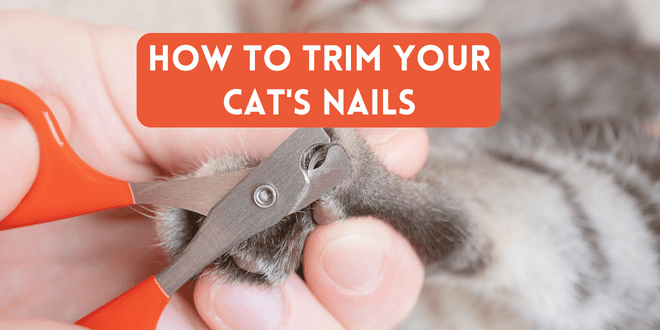
If your cat becomes Houdini and magically vanishes whenever you even think about trimming his nails, part of the problem might be he has learned to associate the procedure with restraint, discomfort, fear, or even pain. Even if you do manage to accomplish the nail trimming procedure, if you’ve had to wrap your cat in a towel, enlist the help of family members to hold him down, restrain by scruffing or have punished in any way for being a wiggle worm, then all that just compounds the problem. If your cat dislikes the process now, he’ll absolutely hate it the next time and then go into full panic mode the time after that.
Nail Trimming Shouldn’t be Stressful
Ok, it may not top the list of your cat’s favorite things to do, but it shouldn’t create a wave of panic and should definitely not result in hissing, growling, biting or scratching (by the cat or by you!). When done correctly, it should be a quick, easy, and dare I say, pleasant experience.
Develop Trust With Your Cats
If you’re dealing with a kitten, don’t waste time – start getting him comfortable with having his paws touched and nails trimmed. This is the ideal time because if you get your kitten comfortable with it from the very beginning it will be a lot easier when he’s an adult.
If you’re dealing with a cat who has never had his nails trimmed or has had a less-than-happy experience with the procedure, you’ll have to take it slow and do some trust-building. For this, you won’t even get out the clippers or attempt to trim one nail. Your main objective during this phase is to show your cat having his paws touched is a good thing.
The Velvet Touch
Choose a time to begin the training when your cat is relaxed and maybe even a bit sleepy. Arm yourself with some treats. Gently touch a paw and then offer a treat. If your cat has never been comfortable with having his paws touched then make sure when you do touch, it’s for no more than a couple of seconds – just one gentle stroke.
Work up to being able to pet each of the paws and then to being able to lift and hold one paw for a few seconds. When you hold a paw don’t grasp it – just let it sit in your hand for the count of three. Reward your cat with a treat for his tolerance.
The next step is to hold a paw and gently press to allow the nail to extend. Be very gentle. Reward your cat. Do this with all of the paws.
Do the above exercises a couple of times a day until you feel your cat is completely comfortable with having his paws held and gently pressed so the nails are exposed. Remember to always reward your cat with a treat for acceptance of each move you make.
Choose the Right Nail Clipper for Your Cat’s nails
Get a nail clipper meant for cat nails. Don’t use a dog nail clipper (too big) and don’t use clippers meant for human fingernails (they’ll split the nails). The cat’s nails are smaller and thinner so use clippers specifically designed for their size and shape.
Avoid Cutting the Quick
There’s a blood supply running through the nail. If your cat’s nails are light-colored you can see the pink part. That’s called the quick and it contains nerves and the blood supply. If you cut the quick you’ll cause pain to your cat and it’ll also result in bleeding. Cutting the quick, in addition to causing pain, will undo the good behavior work and your cat may develop a fear of the procedure.Only cut the very tip of the nail – don’t go beyond the curve. If your cat’s nails are light-colored, it’s much easier to see the quick, but if they’re dark-colored, you have to be even more careful. Always cut less than you think you should. If you’re at all in doubt about how much to trim, have your veterinarian or one of the clinic’s veterinary technicians show you.
If you do accidentally cut the quick, stop the bleeding with a little cornstarch. Keep a small container of cornstarch with your grooming supplies just to be on the safe side. Hopefully though, you’ll never need it.
Trimming Your Cat’s Nails
If your cat has had negative experiences with nail trimming, you shouldn’t attempt to do more than one or nails during each trimming session. It’s better to have the whole procedure over and done before your cat even realizes what just happened. If you keep the experience quick and positive, your cat will be more relaxed next time around.
Choose a time for nail trimming when your cat is relaxed. Hold the nail trimmer with one hand and take your cat’s paw in the other hand. Gently press to expose a nail and do a quick, but careful snip. If the cat reacts, don’t attempt to do any more nails. If your cat is calm, do another. Always end on a positive note so it’s better to come back and do a couple more nails later, rather than have a struggle and undo all the good behavior modification work you’ve been doing.
It will also help the process if you keep track of which paw you’re working on so you’ll know where you left off when it’s time to do a couple more nails. The less you have to hold a paw while you double-check whether you’ve already cut those nails, the better.
How Often Should You Trim Your Cat’s Nails?
Typically, once a month is sufficient but that will depend on how fast your particular cat’s nails grow.
Your Cat’s Scratching Post
Don’t be surprised if your cat races over to the scratching post after you’ve trimmed nails. It’s actually a good way for kitty to complete the manicure. It’s a typical behavior used to displace any concern your cat had about the procedure, or just from having to sit still. In our house, it’s standard practice for my cat to head directly to her post as soon as the last nail has been trimmed. That is, after she receives her treat, of course.
What About Declawing?
Declawing is not a humane option and shouldn’t be viewed as a way to avoid nail trimming. Being able to scratch is a vital part of being a cat. Declawing is the equivalent of mini amputations. Scratching behavior serves many vital emotional and physical functions for a cat. If your cat is engaging in furniture scratching, then provide an appealing scratching post, place it near the area where he’s scratching and reward for using the post. If you’re considering declawing your cat because you are unable to trim nails, your veterinarian will teach you how to do it or you can bring your cat in to have a veterinary technician do the nail trim.
Need More Information?
For more information on cat behavior and training, refer to the books by Pam Johnson-Bennett. Pam’s books are available at bookstores and also online. We’ve included links to Amazon here on our website.
If you have a question regarding your cat’s behavior or health, please contact your veterinarian. This article is not intended as a replacement for your cat’s veterinary care. This article is for information purposes only and not offering medical advice or providing a medical diagnosis.





